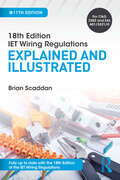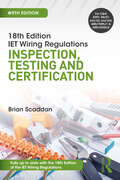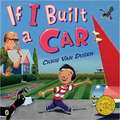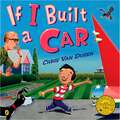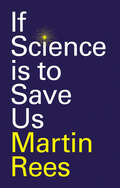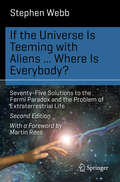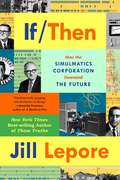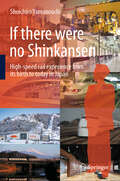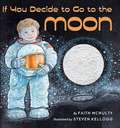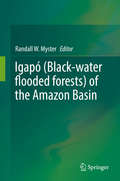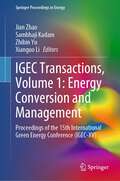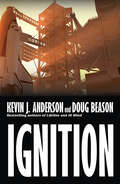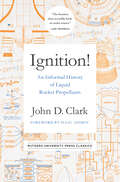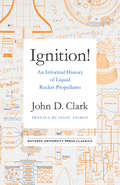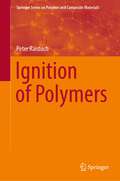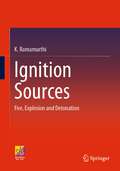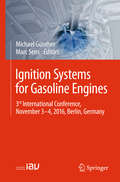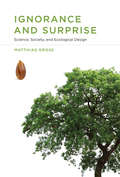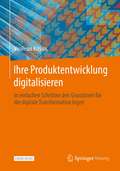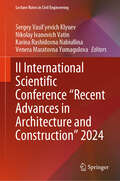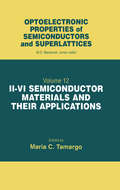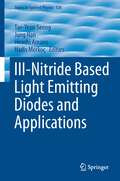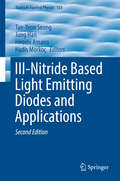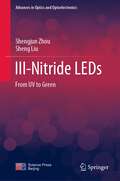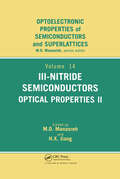- Table View
- List View
IET Wiring Regulations: Explained and Illustrated, 11th ed
by Brian ScaddanThis popular guide focuses on common misconceptions in the application of the IET Wiring Regulations. It explains in clear language those parts of the regulations that most need simplifying, outlining the correct procedures to follow and those to avoid. Emphasis has been placed on areas where confusion and misinterpretation are common, such as earthing and bonding, circuit design and protection, and in particular the increased use of RCDs. With the content covering the requirements of both City & Guilds and EAL courses and containing sample exam questions and answers, this book is also an ideal revision guide.
IET Wiring Regulations: Inspection, Testing and Certification, 9th ed
by Brian ScaddanThis popular guide clarifies the requirements for inspection and testing, explaining in clear language those parts of the IET Wiring Regulations that most need simplifying. In addition to the descriptive and diagrammatic test methods that are required, explanations of the theory and reasoning behind test procedures are given, together with useful tables for the comparison of test results. The book also provides essential information on the completion of electrical installation certificates, with a step-by-step guide on the entries that need to be made and where to source data. With the content suitable for both City & Guilds and EAL Inspection and Testing courses and containing a sample MCQ paper and answers, it is also an ideal revision guide. Fully up to date with the latest amendments to the 18th Edition of the IET Wiring Regulations. Simplifies the advice found in the Wiring Regulations, explaining how they apply to working practice for inspection, testing and certification. Expert advice from an engineering training consultant, supported with colour diagrams, examples and key data.
If I Built a Car
by Chris Van Dusen"If I built a car, it'd be totally new! Here are a few of the things that I'd do. . . . " Jack has designed the ultimate fantasy car. Inspired by zeppelins and trains, Cadillacs and old planes, with brilliant colors and lots of shiny chrome, this far-out vision is ready to cruise! there's a fireplace, a pool, and even a snack bar! After a tour of the ritzy interior, robert the robot starts up the motor . . . and Jack and his dad set off on the wildest test drive ever!
If I Built a Car (If I Built Series)
by Chris Van DusenIf I built a car, it'd be totally new!Here are a few of the things that I'd do. . . .Young Jack is giving an eye-opening tour of the car he'd like to build. There's a snack bar, a pool, and even a robot named Robert to act as chauffeur. With Jack's soaring imagination in the driver's seat, we're deep-sea diving one minute and flying high above traffic the next in this whimsical, tantalizing take on the car of the future. Illustrations packed with witty detail, bright colors, and chrome recall the fabulous fifties and an era of classic American automobiles. Infectious rhythm and clever invention make this wonderful read-aloud a launch pad for imaginative fun.
If Science is to Save Us
by Martin ReesThere has never been a time when &‘following the science&’ has been more important for humanity. At no other point in history have we had such advanced knowledge and technology at our fingertips, nor had such astonishing capacity to determine the future of our planet. But the decisions we must make on how science is applied belong outside the lab and should be the outcome of wide public debate. For that to happen, science needs to become part of our common culture. Science is not just for scientists: if it were, it could never save us from the multiple crises we face. For science can save us, if its innovations mesh carefully into society and its applications are channelled for the common good. As Martin Rees argues in this expert and personal analysis of the scientific endeavour on which we all depend, we need to think globally, we need to think rationally and we need to think long-term, empowered by twenty-first-century technology but guided by values that science alone cannot provide.
If the Universe Is Teeming with Aliens ... WHERE IS EVERYBODY?
by Stephen WebbGiven the fact that there are perhaps 400 billion stars in our Galaxy alone, and perhaps 400 billion galaxies in the Universe, it stands to reason that somewhere out there, in the 14-billion-year-old cosmos, there is or once was a civilization at least as advanced as our own. The sheer enormity of the numbers almost demands that we accept the truth of this hypothesis. Why, then, have we encountered no evidence, no messages, no artifacts of these extraterrestrials? In this second, significantly revised and expanded edition of his widely popular book, Webb discusses in detail the (for now!) 75 most cogent and intriguing solutions to Fermi's famous paradox: If the numbers strongly point to the existence of extraterrestrial civilizations, why have we found no evidence of them? Reviews from the first edition: "Amidst the plethora of books that treat the possibility of extraterrestrial intelligence, this one by Webb . . . is outstanding. . . . Each solution is presented in a very logical, interesting, thorough manner with accompanying explanations and notes that the intelligent layperson can understand. Webb digs into the issues . . . by considering a very broad set of in-depth solutions that he addresses through an interesting and challenging mode of presentation that stretches the mind. . . . An excellent book for anyone who has ever asked 'Are we alone?'. " (W. E. Howard III, Choice, March, 2003) "Fifty ideas are presented . . . that reveal a clearly reasoned examination of what is known as 'The Fermi Paradox'. . . . For anyone who enjoys a good detective story, or using their thinking faculties and stretching the imagination to the limits . . . 'Where is everybody' will be enormously informative and entertaining. . . . Read this book, and whatever your views are about life elsewhere in the Universe, your appreciation for how special life is here on Earth will be enhanced! A worthy addition to any personal library. " (Philip Bridle, BBC Radio, March, 2003) Since gaining a BSc in physics from the University of Bristol and a PhD in theoretical physics from the University of Manchester, Stephen Webb has worked in a variety of universities in the UK. He is a regular contributor to the Yearbook of Astronomy series and has published an undergraduate textbook on distance determination in astronomy and cosmology as well as several popular science books. His interest in the Fermi paradox combines lifelong interests in both science and science fiction.
If Then: How Simulmatics Corporation Invented The Future
by Jill LeporeLonglisted • Financial Times & McKinsey Business Book of the Year A revelatory account of the Cold War origins of the data-mad, algorithmic twenty-first century, from the author of the acclaimed international bestseller These Truths. The Simulmatics Corporation, launched during the Cold War, mined data, targeted voters, manipulated consumers, destabilized politics, and disordered knowledge—decades before Facebook, Google, and Cambridge Analytica. Jill Lepore, best-selling author of These Truths, came across the company’s papers in MIT’s archives and set out to tell this forgotten history, the long-lost backstory to the methods, and the arrogance, of Silicon Valley. Founded in 1959 by some of the nation’s leading social scientists—“the best and the brightest, fatally brilliant, Icaruses with wings of feathers and wax, flying to the sun”—Simulmatics proposed to predict and manipulate the future by way of the computer simulation of human behavior. In summers, with their wives and children in tow, the company’s scientists met on the beach in Long Island under a geodesic, honeycombed dome, where they built a “People Machine” that aimed to model everything from buying a dishwasher to counterinsurgency to casting a vote. Deploying their “People Machine” from New York, Washington, Cambridge, and even Saigon, Simulmatics’ clients included the John F. Kennedy presidential campaign, the New York Times, the Department of Defense, and dozens of major manufacturers: Simulmatics had a hand in everything from political races to the Vietnam War to the Johnson administration’s ill-fated attempt to predict race riots. The company’s collapse was almost as rapid as its ascent, a collapse that involved failed marriages, a suspicious death, and bankruptcy. Exposed for false claims, and even accused of war crimes, it closed its doors in 1970 and all but vanished. Until Lepore came across the records of its remains. The scientists of Simulmatics believed they had invented “the A-bomb of the social sciences.” They did not predict that it would take decades to detonate, like a long-buried grenade. But, in the early years of the twenty-first century, that bomb did detonate, creating a world in which corporations collect data and model behavior and target messages about the most ordinary of decisions, leaving people all over the world, long before the global pandemic, crushed by feelings of helplessness. This history has a past; If Then is its cautionary tale.
If there were no Shinkansen: High-speed rail experience from its birth to today in Japan
by Shuichiro YamanouchiThis book is the first book written in English about the secret story of the birth of the Shinkansen in Japan and its subsequent developments. The author, Mr. Shuichiro Yamanouchi, a former chairman of East Japan Railway (JR East), addresses what the essence of Shinkansen technology is and how it could be achieved in such a short time. And the book, written based on his long experience in railway engineering and management, gives readers a bird's-eye view of the Japanese railway as a whole, and the technical philosophy of his great career behind it. In this book, its whole picture is clarified, that is, the world's first 200 km/h running, dealing with troubles after the opening, and development of the 300 km/h commercial operation after that, including the failure stories encountered in the process. These gave a big stimulation to the development of other high-speed railways, and this book helps readers to learn about the accumulated experiences of Japanese high-speed railways that have not been revealed so far, such as railway safety, noise against the environment, railway privatization, harmonization of management and engineering, and so forth."
If You Decide to Go to the Moon
by Faith McNulty Steven Kellogg"If you decide to go to the moon," writes Faith McNulty, "read this book first. It will tell you how to get there and what to do after you land. The most important part tells you how to get home." Written in the second person, the text allows the reader to participate in every aspect of the journey, from packing ("don't forget your diary and plenty of food") to liftoff (at first you'll feel heavy; don't worry") to traveling through space (where "the moon glows like a pearl in the black, black sky"). The reader lands at the Sea of Tranquility, the site of the first lunar landing
Igapó (Black-water flooded forests) of the Amazon Basin
by Randall W. MysterIgapó forests are a common part of the Amazon whose ecosystems are critical to our shared human future. The introduction addresses the structure, function and dynamics of igapó forests in the Amazon basin, focusing on their uniqueness due to their high level of complexity defined as the many ways that different components of igapó forests in the Amazon basin ecosystem interact and also on how those interactions are on a higher-order compared to other tropical forests. The text then breaks down the igapó ecosystem using these sections: (1) Igapó forests over space and time, (2) Water, light and soils, (3) The carbon cycle, (4) Litter, fungi and invertebrates, (5) Vertebrates, (6) Plant population studies, (7) Plant community studies, and (8) Human impacts and management. Experts from around the world serve as chapter authors that review what is known about their specific part of the igapó ecosystem, what research they have done, and also what needs to be done in the future.
IGEC Transactions, Volume 1: Proceedings of the 15th International Green Energy Conference (IGEC-XV) (Springer Proceedings in Energy)
by Jian Zhao Sambhaji Kadam Zhibin Yu Xianguo LiThis book is the first volume of the proceedings of the 15th International Green Energy Conference (IGEC) held in Glasgow, UK from 10-13 July 2023. This meeting is the latest in a multi-disciplinary international conference series on the use of energy with no or reduced environmental, social, and economic impacts. The conference provided a platform for sharing new technical information, disseminating high-quality research results, presenting the latest developments in energy and environment, and debating the shaping of future directions and priorities for sustainable development and energy security.This conference proceedings is of particular value and interest to researchers, scientists, engineers, and practitioners from relevant fields of energy and environment, from policy-making and technical development to management and marketing.
Ignition
by Kevin J. Anderson Doug BeasonAn injured astronaut must save NASA from terrorists in this high-tech adventure by the bestselling authors of Lifeline and Ill Wind. Terrorists seize control of the Kennedy Space Center and hold the shuttle Atlantis and its crew hostage on the launchpad. But astronaut &“Iceberg&” Friese, grounded from the mission because of a broken foot, is determined to slip through the swamps and rocket facilities around Cape Canaveral and pull the plug on the terrorists. With their years of experience in the field, Anderson and Beason have packed Ignition with insider information to create an extremely plausible, action-packed thriller. &“Anderson and Beason have written a nail biter full of details about NASA and the Kennedy Space Center.&” —Library Journal
Ignition!: An Informal History of Liquid Rocket Propellants
by John Drury ClarkA classic work in the history of science, and described as “a good book on rocket stuff…that’s a really fun one” by SpaceX founder Elon Musk, readers will want to get their hands on this influential classic, available for the first time in decades. This newly reissued debut book in the Rutgers University Press Classics imprint is the story of the search for a rocket propellant which could be trusted to take man into space. This search was a hazardous enterprise carried out by rival labs who worked against the known laws of nature, with no guarantee of success or safety. Acclaimed scientist and sci-fi author John Drury Clark writes with irreverent and eyewitness immediacy about the development of the explosive fuels strong enough to negate the relentless restraints of gravity. The resulting volume is as much a memoir as a work of history, sharing a behind-the-scenes view of an enterprise which eventually took men to the moon, missiles to the planets, and satellites to outer space.
Ignition!: An Informal History of Liquid Rocket Propellants
by John Drury Clark Isaac AsimovThis newly reissued debut book in the Rutgers University Press Classics Imprint is the story of the search for a rocket propellant which could be trusted to take man into space. This search was a hazardous enterprise carried out by rival labs who worked against the known laws of nature, with no guarantee of success or safety. Acclaimed scientist and sci-fi author John Drury Clark writes with irreverent and eyewitness immediacy about the development of the explosive fuels strong enough to negate the relentless restraints of gravity. The resulting volume is as much a memoir as a work of history, sharing a behind-the-scenes view of an enterprise which eventually took men to the moon, missiles to the planets, and satellites to outer space. A classic work in the history of science, and described as “a good book on rocket stuff…that’s a really fun one” by SpaceX founder Elon Musk, readers will want to get their hands on this influential classic, available for the first time in decades.
Ignition of Polymers (Springer Series on Polymer and Composite Materials)
by Peter RantuchThis book provides an overview of the initiation of combustion processes of polymeric materials. It presents physicochemical processes associated with heating as well as numerical methods for initiation parameter calculation. In addition, the book describes thermal degradation of polymers and the effect of an incident heat flux on initiation time. It then highlights the most commonly used devices for measuring the time to ignition using external heat sources. The target group of this book are scientists and researchers dealing with materials combustion and also graduates and practitioners focused on fire protection.
Ignition Sources: Fire, Explosion and Detonation
by K. RamamurthiThis book discusses the different energy sources bringing about fires, explosions, and detonations in combustibles under different levels of confinement. Focus is on the initiation source for a combustible whether it is a gas, a liquid, or a solid in a given state of confinement. Incidents of oxygen-related fires in hospitals which were particularly evident with increased usage of oxygen therapy for the extremely ill COVID-19 patients in 2021 are discussed with details of formation, accumulation, and dissipation of charges and their discharges leading to fires and explosions. Sympathetic detonations, BLEVE explosions, cook-off tests of combustibles, the inadvertent ignition sources (threats), and their control are discussed. Sporadic Ignition of wildfires in a heat dome augmented by the reflection of expansion disturbances from the interfaces separating media of different acoustic impedances are explored. Spontaneous human combustion, pilot ignition, shock wave ignition, ignition of fuel droplets and conditions under which fires, explosions, and detonations take place are discussed. Different ways of mitigating the inadvertent initiation of explosions and detonations are given at the end.
Ignition Systems for Gasoline Engines
by Michael Günther Marc SensThe volume includes selected and reviewed papers from the 3rd Conference on Ignition Systems for Gasoline Engines in Berlin in November 2016. Experts from industry and universities discuss in their papers the challenges to ignition systems in providing reliable, precise ignition in the light of a wide spread in mixture quality, high exhaust gas recirculation rates and high cylinder pressures. Classic spark plug ignition as well as alternative ignition systems are assessed, the ignition system being one of the key technologies to further optimizing the gasoline engine.
Ignorance and Surprise: Science, Society, and Ecological Design (Inside Technology)
by Matthias GrossThe relationship between ignorance and surprise and a conceptual framework for dealing with the unexpected, as seen in ecological design projects.Ignorance and surprise belong together: surprises can make people aware of their own ignorance. And yet, perhaps paradoxically, a surprising event in scientific research—one that defies prediction or risk assessment—is often a window to new and unexpected knowledge. In this book, Matthias Gross examines the relationship between ignorance and surprise, proposing a conceptual framework for handling the unexpected and offering case studies of ecological design that demonstrate the advantages of allowing for surprises and including ignorance in the design and negotiation processes.Gross draws on classical and contemporary sociological accounts of ignorance and surprise in science and ecology and integrates these with the idea of experiment in society. He develops a notion of how unexpected occurrences can be incorporated into a model of scientific and technological development that includes the experimental handling of surprises. Gross discusses different projects in ecological design, including Chicago's restoration of the shoreline of Lake Michigan and Germany's revitalization of brownfields near Leipzig. These cases show how ignorance and surprise can successfully play out in ecological design projects, and how the acknowledgment of the unknown can become a part of decision making. The appropriation of surprises can lead to robust design strategies. Ecological design, Gross argues, is neither a linear process of master planning nor a process of trial and error but a carefully coordinated process of dealing with unexpected turns by means of experimental practice.
Ihre Produktentwicklung digitalisieren: In einfachen Schritten den Grundstein für die digitale Transformation legen
by Vasileios KitsiosWelche Schritte müssen unternommen werden, um die Produktentwicklung effizienter, verlässlicher und vollständig digital durchzuführen? Dieses Fachbuch vermittelt die notwendigen Inhalte über Systeme, Prozesse und Tools, um in geeigneten Schritten eine vollständige Produktbeschreibung nach den Ein-Quellen-Prinzip zu erzielen. Anhand konkreter Fallbeispiele aus der Automotive und Luftfahrtindustrie wird das Konzept veranschaulicht und dem Leser wird die Umsetzung in 3DExperience R2021x und CATIA V5- 6R2019 demonstriert.
II International Scientific Conference "Recent Advances in Architecture and Construction" 2024 (Lecture Notes in Civil Engineering #627)
by Sergey Vasil'Yevich Klyuev Nikolay Ivanovich Vatin Karina Rashidovna Nabiullina Venera Maratovna YumagulovaThis book gathers the latest advances, innovations, and applications in the field of construction engineering and architecture, as presented by researchers at the II International Scientific Conference “Recent Advances in Architecture and Construction”, held in Kazan, Russia, on May 14–15, 2024. It covers highly diverse topics, including engineering structures, advanced concrete technologies, durable structures, smart structures and materials, smart cities, architectural and environmental design, modern trends in the development of architectural typology, sustainable urban planning, built environment, construction technologies, and construction management. The contributions, which were selected by means of a rigorous international peer-review process, highlight numerous exciting ideas that will spur novel research directions and foster multidisciplinary collaborations.
II-VI Semiconductor Materials and their Applications (Optoelectronic Properties of Semiconductors and Superlattices #12)
by MariaC. TamargoII-VI Semiconductor Materials and Their Applications deals with II-VI compound semiconductors and the status of the two areas of current optoelectronics applications: blue-green emitters and IR detectors. Specifically, the growth, charactrtization, materials and device issues for these two applications are described. Emphasis is placed on the wide bandgap emitters where much progress has occurred recently.The book also presents new directions that have potential, future applications in optoelectronics for II-VI materials. In particular, it discusses the status of dilute magnetic semiconductors for mango-optical and electromagnetic devices, nonlinear optical properties, photorefractive effects and new materials and physics phenomena, such as self-organized, low-dimensional structures.II_VI Semiconductor Materials and Their Applications is a valuable reference book for researchers in the field as well as a textbook for materials science and applied physics courses.
III-Nitride Based Light Emitting Diodes and Applications
by Hadis Morkoç Hiroshi Amano Jung Han Tae-Yeon SeongLight emitting diodes (LEDs) are already used in traffic signals, signage lighting, and automotive applications. However, its ultimate goal is to replace traditional illumination through LED lamps since LED lighting significantly reduces energy consumption and cuts down on carbon-dioxide emission. Despite dramatic advances in LED technologies (e.g., growth, doping and processing technologies), however, there remain critical issues for further improvements yet to be achieved for the realization of solid-state lighting. This book aims to provide the readers with some contemporary LED issues, which have not been comprehensively discussed in the published books and, on which the performance of LEDs is seriously dependent. For example, most importantly, there must be a breakthrough in the growth of high-quality nitride semiconductor epitaxial layers with a low density of dislocations, in particular, in the growth of Al-rich and and In-rich GaN-based semiconductors. The materials quality is directly dependent on the substrates used, such as sapphire, Si, etc. In addition, efficiency droop, growth on different orientations and polarization are also important. Chip processing and packaging technologies are key issues. This book presents a comprehensive review of contemporary LED issues. Given the interest and importance of future research in nitride semiconducting materials and solid state lighting applications, the contents are very timely. The book is composed of chapters written by leading researchers in III-nitride semiconducting materials and device technology. This book will be of interest to scientists and engineers working on LEDs for lighting applications. Postgraduate researchers working on LEDs will also benefit from the issues this book provides.
III-Nitride Based Light Emitting Diodes and Applications
by Hadis Morkoç Hiroshi Amano Jung Han Tae-Yeon SeongLight emitting diodes (LEDs) are already used in traffic signals, signage lighting, and automotive applications. However, its ultimate goal is to replace traditional illumination through LED lamps since LED lighting significantly reduces energy consumption and cuts down on carbon-dioxide emission. Despite dramatic advances in LED technologies (e. g. , growth, doping and processing technologies), however, there remain critical issues for further improvements yet to be achieved for the realization of solid-state lighting. This book aims to provide the readers with some contemporary LED issues, which have not been comprehensively discussed in the published books and, on which the performance of LEDs is seriously dependent. For example, most importantly, there must be a breakthrough in the growth of high-quality nitride semiconductor epitaxial layers with a low density of dislocations, in particular, in the growth of Al-rich and and In-rich GaN-based semiconductors. The materials quality is directly dependent on the substrates used, such as sapphire, Si, etc. In addition, efficiency droop, growth on different orientations and polarization are also important. Chip processing and packaging technologies are key issues. This book presents a comprehensive review of contemporary LED issues. Given the interest and importance of future research in nitride semiconducting materials and solid state lighting applications, the contents are very timely. The book is composed of chapters written by leading researchers in III-nitride semiconducting materials and device technology. This book will be of interest to scientists and engineers working on LEDs for lighting applications. Postgraduate researchers working on LEDs will also benefit from the issues this book provides.
III-Nitride LEDs: From UV to Green (Advances in Optics and Optoelectronics)
by Shengjun Zhou Sheng LiuThis book highlights state-of-the-art in III-nitrides-based light-emitting diodes (LEDs). Motivated by the application prospects in lighting, high-resolution display, and health & medicine, the book systematically introduces the physical fundamentals, epitaxial growth, and device fabrications of III-nitride-based LEDs. Important topics including the structures of chips, device reliability and measurements and the advances in mini and micro LEDs are also discussed. The book is completed with a decade of research experience of the author’s team in the design and fabrication of III-nitrides-based LEDs, presenting the novel achievements in the stress control of the large mismatch heterostructures, defect formation and inhibition mechanism of the heteroepitaxial growth, LED epitaxial technologies, and the fabrication of high-efficient flip-chip LEDs. The book comprises of a valuable reference source for researchers and professionals engaged in the research and development of III-nitrides-based LEDs.
III-Nitride Semiconductors: Optical Properties
by Hongxing JiangThis second part presents a comprehensive overview of fundamental optical properties of the III Nitride Semiconductor. All optoelectronic applications based on III-nitrides are due to their unique optical properties and characterizations of III-nitrides. Much information, which is critical to the design and improvement of optoelectronic devices based on III-nitrides has been obtained in the last several years. This is the second of a two part Volume in the seriesOptoelectronic Properties of Semiconductors and Superlattices.
